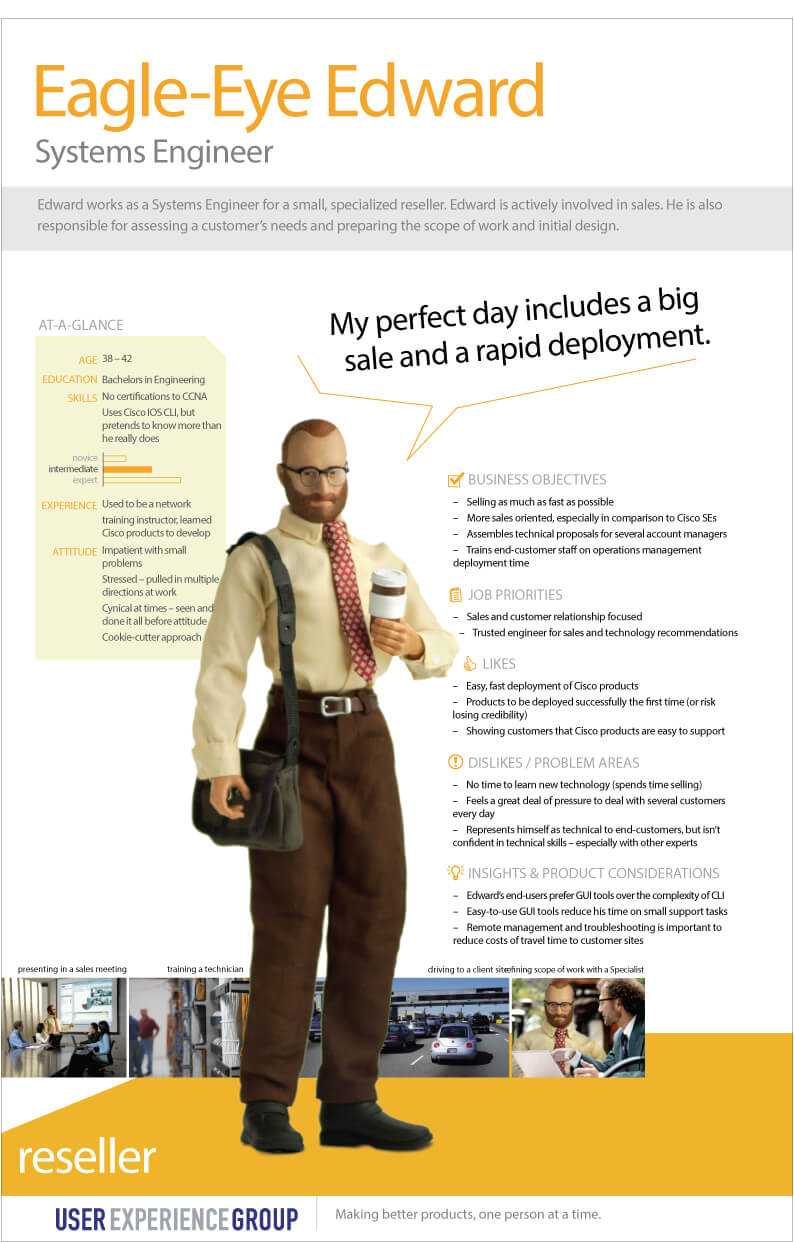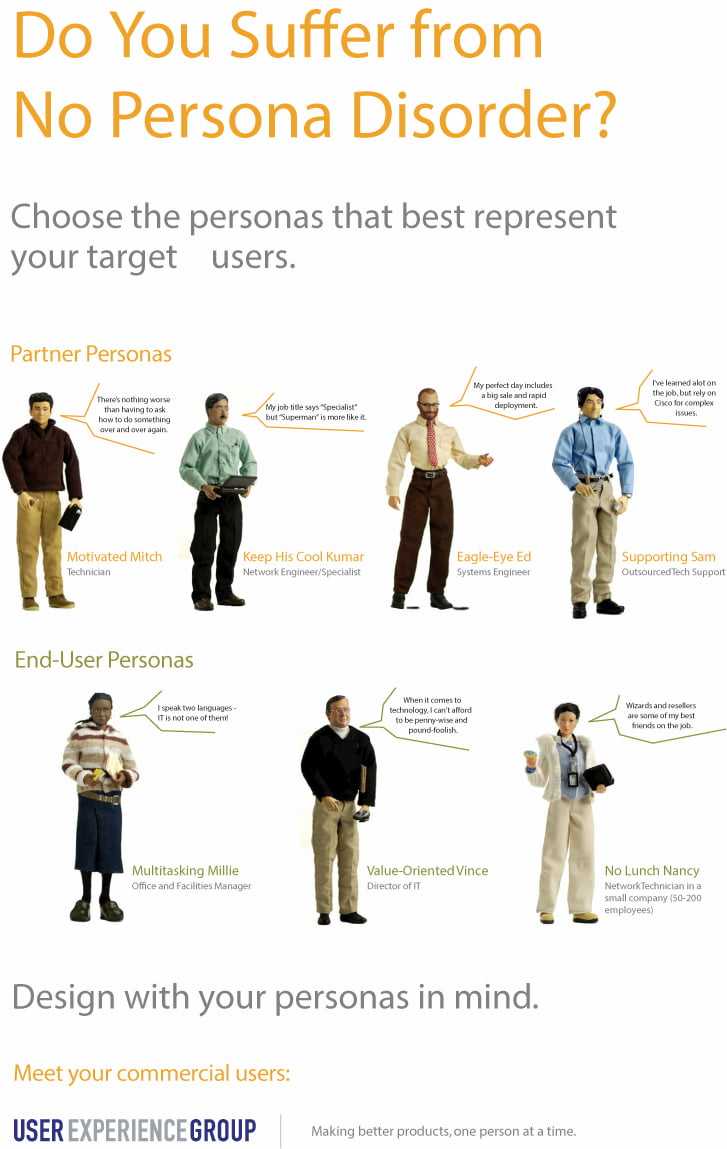Unifying Personas
To inspire and engage internal stakeholders, and align cross-functional teams around a common vision of our users, I innovated with our personas. In producing the definitive set of personas, though we created buzz and aligned cross-functional teams, using action figures stirred controversy in the UX field. I decided it was more important to establish a dialog about what innovation really is and think outside the typical box, rather than follow the traditional UX path.
My UX team had a deep understanding of both conscious and unconscious needs of our users, but also needed to make personas sticky (memorable) for product teams. Before our personas, different product teams used their own personas, which were not based on user research, because nobody had presented personas in a highly professional fashion up to that point. We also noticed that in this particular corporate culture, many engineers collected action figures, such as Captain America, and so on.
At the same time, working in a corporation takes an emotional toll on a team over time, and I wanted to reinvigorate energy and creativity among my UX team. Thus, I decided to use action figures to represent our personas. As I mentioned, doing so also stirred up controversy within the UX field, as purist researchers felt that personas must be represented by a human photo to create empathy. Interestingly, I found no research that proved we cannot empathize with a non-human character (action figure). In fact, I found research suggesting we may be able to empathize just as much. What's more, we found empathy with our non-human personas to be just as high, but much more importantly, we achieved our stated goal—that product teams recollected and recognized our personas and their characteristics much more than if they were not presented in unique and interesting ways. We got their attention, and they loved it!
Fig 1: Eagle-Eye Edward, a Reseller Persona
We even created pop-ups for each persona, and created a poster saying “Collect All Seven!” Shortly thereafter, we found engineers bartering for different pop-up action figures, and several had the whole set on their desks.
Moreover, the UX team won an award for innovation presented by vice presidents from across the company for having developed these personas.
The lesson in this effort is not that we should or should not use human personas or action figures. It is that when innovating, you have to step out of the box that says “this is the way everyone agrees it should be done (so don’t be different!).”
How We Defined and Created These Personas
To craft each persona we of course gathered significant research to understand user characteristics, business objectives, priorities, likes, dislikes, and insights or product considerations. We then defined example physical characteristics of each persona, based on actual people in the roles that the persona represented. We also identified key accessories they carry with them. For example, we highlighted the types of clothes they might wear, the type of briefcase they might carry, the type of cup or mobile phone they might carry, and so on. We then had these personas built as action figures (yeah, dolls), along with these accessories, leveraging a company we worked with in China.
Fig 2: Example Accessories Used to Define a Persona
We then did photo shoots and Photo-shopped the action figures into typical scenarios, within environments where we might typically find them.
Fig 3: Example Photo Shoot- Sales Meeting
Fig 4: Photo Shoot- Working with Expert
Fig 5: Photo Shoot- Driving
Lessons
When people say “you don’t understand; you can’t do it that way,” you need to consider valid concerns, but then find the best way to work around those concerns and drive hard to your larger goal. By nature, innovative ideas represent new ways of thinking, which means you need to drop old ways of thinking and operating. Several "experts" criticized our personas, saying that by showing our customers as dolls, we did not respect them. Quite the contrary: We polled numerous customers, and most of them saw the humor in representing users as action figures. Several even thought we should take it farther and represent them as Action Heroes, with capes and disguises! Rather, I found that in the UX industry, we have a large number of purists who articulate how things should be, and others line up behind them, fearful of trying anything new. In the end, should we use non-human characters to represent personas? Honestly, I am not attached to representing them in any way. The key here is that these personas representations engaged product teams in a dialog about users in a way human characters had not to that point. They created a stickiness, and ensured that product teams developed solutions based on having internalized the characteristics of these archetypical users.
Figure 6: Concept Artwork for a Three-fold Popup, Using Multitasking Millie
In the end, the benefits of this effort were manifold. First, Engineering embraced the concept and engaged with the personas, designing products around these users’ needs. But also, executives got excited about User Experience in ways they had never previously been. For example, as the company was establishing cross-company Councils to break down silos, executive sponsors invited me to work with them to understand their customers, and how to increase our traction with customers. This effort in fact led to two specific initiatives, where the UX group was able to redesign experiences that led to more than $100 Million in revenue above goal. It also led to the Chief Marketing Officer working with me and my team, and to updating the corporate tagline from a technology tagline, to a tagline that put humans at the center of the technology equation. Here are examples of a couple additional marketing artifacts we used to build excitement for these personas.
Figure 7: Persona Pop-up, Front and Back
Figure 8: Internal Persona Marketing Poster- Choose The Right Persona!
Figure 9: Internal Persona Marketing Tool: Collect All 7!
The Value of Persona-based Design
This would not be a complete discussion of personas without highlighting the value of persona-based design. Since Cooper wrote the book The Inmates Are Running the Asylum back in the early 1990’s, different organizations have begun leveraging personas in different ways, for different purposes. Having said this, a Marketing persona is different from a persona used for design and development. A dev-based persona is an archetypical representation of up to three of the target users for your product. You include key attributes and attitudes, both conscious and unconscious, but only as they relate to the use of your product, site, or the products sold on your site. The persona details have to highlight possible attractors and challenges. What are the persona’s likes, loves, dislikes, challenges, and hates. In my Logical-Emotional design model, we need to design to support user tasks, but also understand how to connect with the user emotionally. For example, what makes them feel cool, or what gives them a deeper sense of meaning? For example, what can you do to make your users the center of attention socially? What can you do to empower your users, to make them appear to be the most intelligent users of products like yours in you domain? So, go document via personas both these process-centered design parameters (how to optimize for user success), as well as emotional connectors. If you do, you will have captured both the logical and the emotional drivers for your product, and your users will defend your solution to the death!
Several books have also emerged that highlight the negative aspects of persona-based design when leveraged improperly. For example, Phil Terry in his book Customers Included suggests that personas are not useful for design. I agree with his larger point, that his Listening Labs are also valuable, because they provide insights into real user needs. However, when scaling across multiple developers, teams, and projects, persona-based design can be extremely valuable. Yes, teams need to include only useful information in persona definitions. For example, I've seen personas for digital designs that include the persona's height. Useful? Not a chance, unless you're designing something physical, like a pair of pants or a cockpit for a car or airplane. But, if you have the right UX leader driving your team, they can make sure you have the right persona attributes, and that the designs differentiate!








